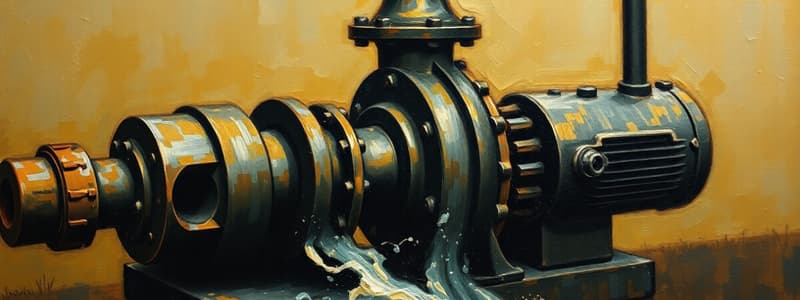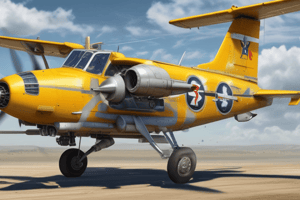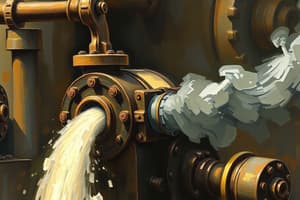Podcast
Questions and Answers
What is the primary purpose of understanding pump performance curves?
What is the primary purpose of understanding pump performance curves?
- To aid troubleshooting and optimize efficiency (correct)
- To determine the manufacturing cost of pumps
- To analyze the aesthetics of pump design
- To select pump materials based on temperature
Which safety measure is essential to prevent injuries during pump operation and maintenance?
Which safety measure is essential to prevent injuries during pump operation and maintenance?
- Increasing the speed of operations
- Choosing lower capacity pumps
- Adopting guardrails and lockout/tagout procedures (correct)
- Implementing regular environmental audits
How can variable speed drives (VSDs) contribute to energy efficiency in pump operations?
How can variable speed drives (VSDs) contribute to energy efficiency in pump operations?
- By adjusting pump speed to match demand patterns (correct)
- By increasing the constant speed setting of the pump
- By reducing the overall flow rate regardless of demand
- By stabilizing pressure across the system
In which application would a driver pump be least likely used?
In which application would a driver pump be least likely used?
What is a crucial factor in maintaining mechanical integrity and safety in pump operations?
What is a crucial factor in maintaining mechanical integrity and safety in pump operations?
What is the primary principle behind centrifugal pumps?
What is the primary principle behind centrifugal pumps?
Which pump type is best suited for applications requiring high pressure and intermittent flow?
Which pump type is best suited for applications requiring high pressure and intermittent flow?
What is a significant drawback of using steam turbines as a drive mechanism for pumps?
What is a significant drawback of using steam turbines as a drive mechanism for pumps?
Which factors must be considered when selecting a pump?
Which factors must be considered when selecting a pump?
What is essential for ensuring system function in pump design?
What is essential for ensuring system function in pump design?
What aspect of pump operation and maintenance is crucial to avoid equipment failure?
What aspect of pump operation and maintenance is crucial to avoid equipment failure?
What role do pressure gauges and flow meters play in pump operation?
What role do pressure gauges and flow meters play in pump operation?
Which drive mechanism offers high torque and variable speed for driver pumps?
Which drive mechanism offers high torque and variable speed for driver pumps?
Flashcards
Driver pumps
Driver pumps
Pumps designed to move fluids in industrial applications. They use different drive mechanisms like electric motors, steam turbines, or hydraulics to achieve specific requirements.
Centrifugal pumps
Centrifugal pumps
These pumps use an impeller rotating inside a casing to create centrifugal force, pushing the liquid outwards and generating flow.
Positive displacement pumps
Positive displacement pumps
They increase pressure by forcing fluid through a fixed volume, using components like pistons, vanes, or gears. They are suitable for tasks requiring high pressure but lower flow rate.
Reciprocating pumps
Reciprocating pumps
Signup and view all the flashcards
Electric motors
Electric motors
Signup and view all the flashcards
Steam turbines
Steam turbines
Signup and view all the flashcards
Hydraulic systems
Hydraulic systems
Signup and view all the flashcards
Pump sizing
Pump sizing
Signup and view all the flashcards
Pump Performance Curve
Pump Performance Curve
Signup and view all the flashcards
Safety Measures for Pumps
Safety Measures for Pumps
Signup and view all the flashcards
Pump Inspections
Pump Inspections
Signup and view all the flashcards
Energy Efficient Pumps
Energy Efficient Pumps
Signup and view all the flashcards
Variable Speed Drives (VSDs)
Variable Speed Drives (VSDs)
Signup and view all the flashcards
Study Notes
Driver Pump Operation
- Driver pumps move fluids, often industrially, with specific applications requiring specialized pumps.
- Pump type and drive mechanism (e.g., electric motor, steam turbine, hydraulics) affect efficiency and maintenance.
- Choosing the correct pump involves evaluating fluid properties (viscosity, density, temperature), pressure, flow rate, and operating conditions.
Pump Types
- Various pump types serve different purposes.
- Centrifugal pumps use impeller rotation to transfer liquids, efficient at higher flow rates.
- Positive displacement pumps increase pressure by pushing fluid through a fixed volume. Includes piston, rotary vane, and gear pumps, commonly used at lower flow rates and higher pressures.
- Reciprocating pumps use a reciprocating motion to move fluid. Examples include piston and diaphragm pumps, suitable for high pressure or intermittent flow applications.
Drive Mechanisms
- Electric motors are versatile and controllable pump drive systems.
- Steam turbines provide high power but are complex to control and maintain.
- Hydraulic systems offer variable speed and high torque, sometimes used with specialized motors.
System Design Considerations
- Proper pump sizing is vital for system function, considering flow and pressure requirements.
- Piping and valve configuration are essential for efficient fluid flow and pressure control.
- System design balances pump performance and environmental impact (noise, energy use).
- Selecting pump and drive components considering torque, speed, lifecycle costs, and material compatibility with the fluid.
Operation and Maintenance
- Regular maintenance schedules, based on use or time, are crucial to avoid downtime.
- Monitoring pump performance using pressure gauges and flow meters is important.
- Tracking data (energy usage, fluid temperature, component wear) helps predict maintenance.
- Understanding pump performance curves (flow rate vs. pressure head) aids troubleshooting and efficiency.
Safety Considerations
- Essential safety measures include guardrails and lockout/tagout procedures.
- Regular inspections for mechanical integrity and leaks are necessary.
- Following safety regulations (e.g., OSHA standards) is legally required.
- Procedures for addressing potential hazards (e.g. in the pump or surrounding area) must be defined.
Energy Efficiency
- High-efficiency pumps and motors reduce operating costs.
- Variable speed drives (VSDs) optimize energy use by adjusting pump speed.
- System design choices (e.g., piping) impact energy consumption.
Specific Applications
- Driver pumps are used in:
- Water/wastewater treatment.
- Chemical processing.
- Oil/gas industries.
- Irrigation/agriculture.
- Food/beverage processing.
- Power generation.
- Applications consider flow rate, pressure, temperature tolerance, and material compatibility.
Studying That Suits You
Use AI to generate personalized quizzes and flashcards to suit your learning preferences.




